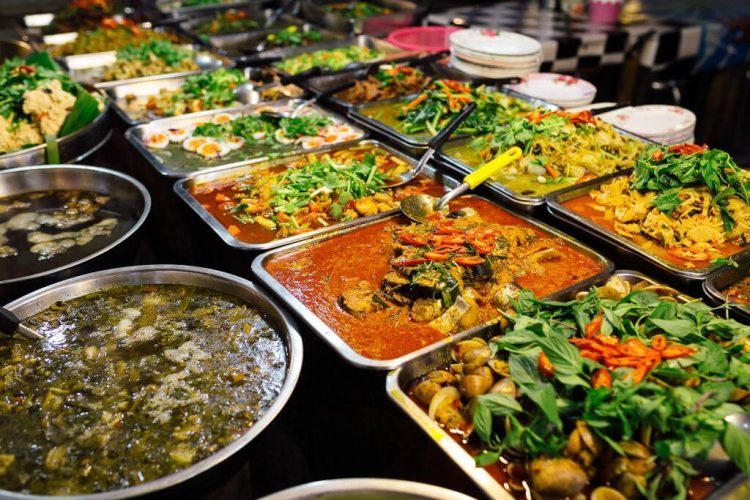Southeast Asia is a haven for food lovers, and its vibrant street food culture is a true reflection of the region’s diverse culinary traditions. From the bustling streets of Bangkok to the night markets of Taiwan, Southeast Asia’s street food offers a sensory overload of flavors, colors, and textures that are unique to each country. Whether you’re wandering through the alleyways of Vietnam, navigating the busy streets of Kuala Lumpur, or sipping bubble tea in Taiwan, the region’s street food scene provides an unforgettable experience.
Street food in Southeast Asia isn’t just about grabbing a quick bite; it’s an integral part of daily life and a chance to savor authentic flavors that have been passed down through generations. In this article, we will take you on a culinary journey through Southeast Asia, exploring the iconic street food dishes, their cultural significance, and the best places to experience them.
1. The Rich Tapestry of Street Food in Southeast Asia
Southeast Asia is home to a melting pot of cultures, and this is reflected in the street food offerings. The culinary influences in the region come from various sources, including Chinese, Indian, and indigenous traditions. Each country in Southeast Asia has its own distinct style of street food, and the dishes are often based on fresh, locally sourced ingredients that showcase the region’s rich agricultural landscape.
Street Food as a Cultural Experience
Street food is more than just sustenance—it’s an essential part of Southeast Asia’s social fabric. In many countries, eating street food is a communal experience, and food vendors serve as the heart of the community, offering not just food but a sense of connection and tradition. In some places, street food is not limited to late-night snacks but is part of the daily ritual of life, where breakfast, lunch, and dinner can all be enjoyed at the many bustling stalls and markets.
2. Thailand: A Paradise for Street Food Lovers
Thailand’s street food scene is legendary, offering an endless array of dishes that are as delicious as they are affordable. Thai street food is known for its bold flavors, including a perfect balance of sweet, salty, sour, and spicy elements. From the famous Pad Thai to the fragrant Tom Yum soup, Thailand’s street food is a reflection of the country’s rich culinary heritage.
Must-Try Thai Street Food
- Pad Thai: Thailand’s most famous dish, Pad Thai consists of stir-fried rice noodles, eggs, tofu, shrimp, and peanuts, flavored with tamarind, fish sauce, and chili. It’s served with lime wedges and often topped with fresh bean sprouts.
- Som Tum (Green Papaya Salad): A refreshing and spicy salad made with shredded green papaya, chili, lime, fish sauce, peanuts, and palm sugar. It’s an iconic dish in Thailand, offering a tantalizing mix of flavors.
- Mango Sticky Rice: A popular dessert made with sticky rice, fresh mango, and coconut milk. Sweet, creamy, and satisfying, it’s a must-have for anyone with a sweet tooth.
Best Places to Try Thai Street Food
- Yaowarat (Chinatown), Bangkok: Yaowarat is known for its vibrant street food scene, offering dishes like dim sum, grilled satay, and deep-fried fish cakes.
- Chatuchak Weekend Market, Bangkok: A food lover’s paradise, this market offers an extensive selection of street food, including crispy fried chicken, coconut ice cream, and Thai iced tea.
3. Vietnam: Flavors of the Streets from Hanoi to Ho Chi Minh City
Vietnam’s street food scene is a reflection of the country’s long history and diverse culinary influences, including French, Chinese, and indigenous flavors. Vietnamese street food is often characterized by fresh ingredients, balanced flavors, and aromatic herbs. Pho, the national dish, and banh mi, the famous Vietnamese sandwich, are just the beginning of the culinary journey.
Must-Try Vietnamese Street Food
- Pho: This iconic Vietnamese noodle soup features a fragrant broth made from beef or chicken, rice noodles, and a variety of fresh herbs like basil, lime, and cilantro. It’s a hearty and satisfying dish that can be enjoyed at any time of day.
- Banh Mi: A fusion of French and Vietnamese flavors, banh mi is a crispy baguette filled with savory ingredients like grilled pork, pate, pickled vegetables, and fresh cilantro. It’s the perfect balance of crunch and freshness.
- Goi Cuon (Spring Rolls): Fresh rice paper rolls stuffed with shrimp, vegetables, herbs, and vermicelli noodles, often served with a delicious dipping sauce. These light and healthy rolls are a favorite street food in Vietnam.
Best Places to Try Vietnamese Street Food
- Hanoi Old Quarter: Hanoi is famous for its street food, with streets lined with vendors offering hot bowls of pho, banh cuon, and bun cha (grilled pork with noodles).
- Ben Thanh Market, Ho Chi Minh City: One of the most famous markets in Vietnam, this bustling market offers a wide range of street food, including com tam (broken rice) and fresh seafood.

4. Malaysia: A Fusion of Flavors on Every Corner
Malaysia’s street food is a reflection of its multicultural society, with Chinese, Indian, Malay, and Peranakan influences blending together to create unique and exciting flavors. Kuala Lumpur and Penang are renowned for their street food, offering everything from spicy curries to Chinese-style dim sum.
Must-Try Malaysian Street Food
- Char Kway Teow: A flavorful stir-fried noodle dish made with flat rice noodles, prawns, eggs, bean sprouts, and Chinese sausage, often cooked with a smoky charred flavor from the wok.
- Nasi Lemak: Considered Malaysia’s national dish, nasi lemak consists of coconut rice served with sambal (chili paste), fried anchovies, peanuts, cucumber, and a boiled egg. It’s often served with a side of fried chicken or beef rendang.
- Roti Canai: An Indian-influenced flatbread that’s crispy on the outside and soft on the inside, often served with dal (lentil curry) or meat curries.
Best Places to Try Malaysian Street Food
- Penang: Known for its delicious street food, Penang is famous for dishes like assam laksa (spicy noodle soup), char kway teow, and penang laksa.
- Jalan Alor, Kuala Lumpur: A famous street food hub, Jalan Alor offers everything from satay and grilled seafood to sweet treats like cendol (a dessert made with shaved ice, coconut milk, and palm sugar).
5. Indonesia: A Flavorful Journey Through the Archipelago
Indonesia’s street food culture is diverse and influenced by the country’s many ethnic groups. From the busy streets of Jakarta to the night markets of Yogyakarta, Indonesian street food is all about bold flavors, with an emphasis on spices, fresh herbs, and grilled meats.
Must-Try Indonesian Street Food
- Nasi Goreng: Indonesia’s beloved fried rice dish, typically made with chicken, shrimp, and vegetables, and served with a fried egg on top. It’s often accompanied by satay (grilled skewers of meat) and krupuk (crispy crackers).
- Sate (Satay): Grilled skewers of marinated meat, often served with a savory peanut sauce. Sate ayam (chicken satay) is one of the most popular varieties.
- Martabak: A stuffed pancake filled with sweet or savory fillings, such as chocolate, nuts, cheese, or minced meat. It’s a popular snack or dessert in Indonesia.
Best Places to Try Indonesian Street Food
- Jakarta: The capital city offers a wide array of street food, from nasi goreng and sate to sweet treats like kue cubir (traditional Indonesian cakes).
- Yogyakarta: Known for its traditional street food, Yogyakarta offers dishes like gudeg (jackfruit stew) and bakpia (sweet pastry).
6. The Future of Southeast Asian Street Food: Innovation Meets Tradition
While Southeast Asia’s street food remains deeply rooted in tradition, modern chefs and vendors are bringing new ideas to the table. From fusion dishes combining traditional ingredients with global flavors to health-conscious alternatives like vegan and gluten-free street food, the future of Southeast Asian street food is as exciting as it is diverse.
Sustainability in Street Food
As the demand for sustainable practices grows, many street food vendors are now incorporating eco-friendly materials, reducing waste, and using locally sourced ingredients. The trend toward sustainability is helping to preserve both the environment and the integrity of the street food tradition.
Conclusion: A Culinary Adventure Like No Other
Street food in Southeast Asia is a vibrant and essential part of the region’s culinary identity. Whether you’re savoring a spicy bowl of Pho in Vietnam, biting into a crispy Char Kway Teow in Malaysia, or indulging in a sweet Mango Sticky Rice in Thailand, the diverse flavors and textures of Southeast Asia’s street food are sure to delight. For any food lover, a street food journey through Southeast Asia is an experience that combines adventure, culture, and, of course, unforgettable tastes.





















